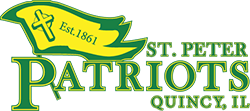Curriculum Mapping
In 2011, the teachers of St. Peter School started a curriculum mapping initiative. In 2018, the teachers from Blessed Sacrament, St. Dominic, St. Francis and St. Peter School began working together on curriculum mapping. The teachers collaborate in grade level teams sharing what is currently being taught and comparing to state and national standards. They create QCES maps with common standards, essential questions, content, and skills. In addition, each school has expanded maps containing specific technology, assessment and resources.
Curriculum Mapping benefits all of the QCES students, teachers, and parents. Below are just a few of the positive ways it impacts the school community.
Horizontal Alignment – teachers at each grade level collaborate to ensure they are teaching the same content and skills.
Vertical Alignment – teachers preschool through 8th grade collaborate to have a fluid curriculum from one grade to another. Teachers review and revise all maps looking for gaps and redundancies.
Cross Disciplinary – academic, physical education, music, and technology teachers at each grade collaborate on shared content and skills.
Meeting Standards – teachers compare what they are teaching to the Illinois State Standards incorporating the National Common Core, Next Generation Science Standards, and National Curriculum Standards for Social Studies to make sure what they are teaching is age appropriate and aligned with national and state expectations.
Curriculum Maps contain standards, essential questions, content, skills, assessment, resources, and technology.
Standards
- Illinois Early Learning and Development Standards
- Illinois State Standards incorporating the National Common Core
- Next Generation Science Standards
- National Curriculum Standards for Social Studies
Essential Questions
- Overarching questions that provide focus for the unit and are aligned to the big ideas, concepts, or themes.
- Guide instruction.
- Focus on “why is this important”.
- Encourage higher level thinking.
- Help students make connections beyond content being studied.
- Ex: How do natural hazards impact humans?
Content
- Subject matter key concepts, targeted facts, and core content.
- Content needed to teach so students can respond to essential question.
- Ex: Natural Hazards
Skills
- What students need to know or be able to do in order to demonstrate mastery or understanding of the content.
- Ex: Discuss the causes and effects of natural hazards
Assessment
- Summative products and performances that are demonstrations of learning and are observable evidence of competence.
- Focus on learning of essential questions.
- Ex: Whole group discussion and Natural Hazard Flipbook
Resources
- All major materials used.
- Ex: Delta Science Kit (2011)
Technology
- Technology equipment and resources incorporated into unit.
- Ex: iPads, Computer, Elmo, SMART Board, YouTube
Curriculum Maps by subject. All grades are listed in the files listed below (PreK3-8th Grade).
Updated for the 2022-2023 School Year
The maps are available to download in PDF format. They may be viewed with your web browser (Ex. Chrome & Edge) or with a PDF Viewer (Ex. Adobe).
English Curriculum is currently being updated. Changes will listed on this page once they are finalized. If you have any questions please call the school at 217-223-1120.
Math Curriculum Map (PreK3-8th Grade)
Science Curriculum Map (PreK3-8th Grade)
Social Studies Curriculum Map (PreK3-8th Grade)
